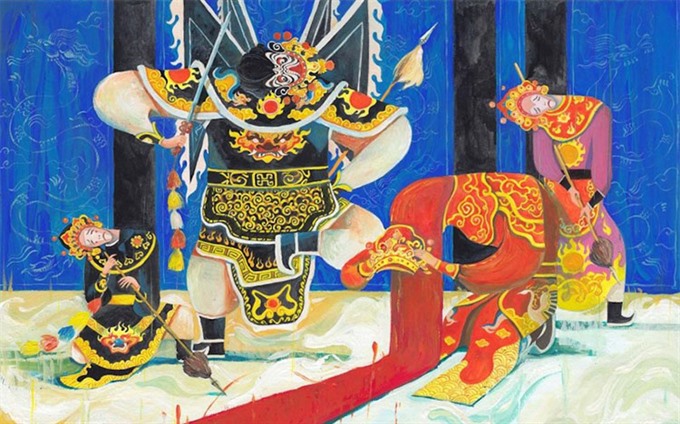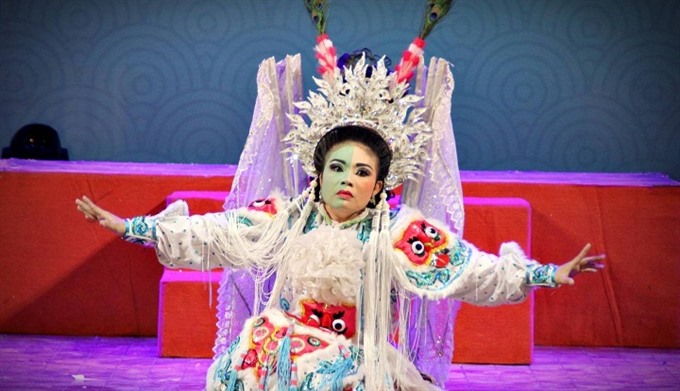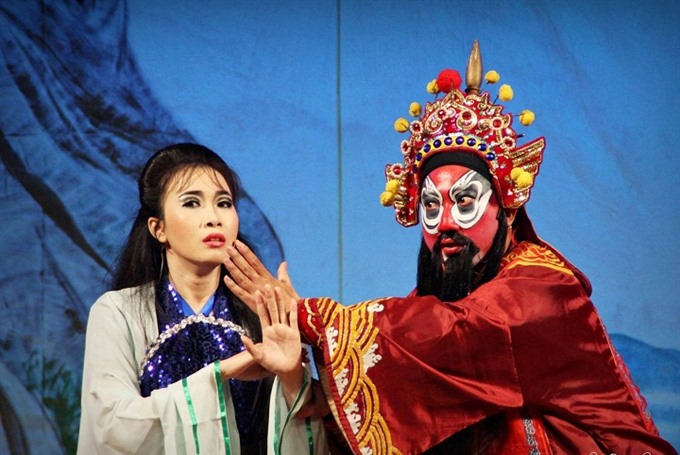 Features
Features

The HCM City Hát Bội Theatre has launched its new free programme offering hát bội or tuồng (classical drama) performances for primary school studentsas part of the theatre’s efforts to attract young audiences.
 |
| A painting on hát bội by artist Phạm Quang Phúc at the exhibition Paint the Art of Hát Bội opened last month in HCM City. The event attracts 140 painters and artists in different fields of theatre, movie and graphic design. (Photo courtesy of the organiser) |
By Anh Thư
The HCM City Hát Bội Theatre has launched its new free programme offering hát bội or tuồng (classical drama) performances for primary school students as part of the theatre’s efforts to attract young audiences.
The programme, Tìm Hiểu Về Hát Bội (Learning Vietnamese Classical Drama of Hát Bội), features more than 30 veteran and young performers, including Meritorious Artist Xuân Quan, and young talents Hà San and Tuấn Nghĩa.
The artists perform popular extracts from historical plays, such as Trần Hưng Đạo Đại Chiến Bạch Đằng Giang (General Trần Hưng Đạo in the Victorious Battle on the Bạch Đằng River) and Trần Quốc Toản (Young Hero Trần Quốc Toản).
They plan to offer 12 shows a year for students in 12 primary schools in six districts in the city.
“We know about pop music but have no knowledge of hát bội. Thanks to artists of HCM City Hát Bội Theatre, we now learn about art and the country’s history, culture and lifestyle through their performances,” said Nguyễn Thanh Tuyền, a student at Lê Chí Trực Primary School in District 3.
Tuyền and her friends also received training in make up, singing and dancing in hát bội from young artists after the show.
 |
| Along with traditional arts such as chèo (traditional opera) in the north and cải lương (reformed theatre) in the south, hát bội has contributed to the spirit and characteristic of Vietnamese. ( Photo courtesy of the theatre) |
 |
| Artists from the HCM City Hát Bội Theatre perform at Giới Thiệu Nghệ Thuật Hát Bội (Introducing Hát Bội), a free programme for visitors staged on HCM City’s Bùi Viện Pedestrian Street in District 1. (Photo courtesy of the theatre) |
According to artist Quan, a co-creator of the programme, hát bội is a unique genre of Vietnamese theatre originating in the 12th century, and “should be introduced in new versions to meet the tastes of youngsters”.
“Through our shows at schools, we hope to preserve and expand the art,” he said.
Last year, Quan and his actors also launched a free programme on Bùi Viện Pedestrian Street in District 1 to introduce the art to foreign visitors.
The programme, Giới Thiệu Nghệ Thuật Hát Bội (Introducing Hát Bội), features 20 young performers trained by People’s Artist Đinh Bằng Phi.
It is staged twice a month on weekends.
Each 60-minute show offers three extracts from historical plays by famous authors such as Đào Tấn, Tống Phước Phổ and Nguyễn Hiền Dĩnh.
Highlighted shows are extracts from Trảm Trịnh Ân (Behead Trịnh Ân) and San Hậu (The Reign), both featuring historic events .
“Our actors are young but their performances have left a very strong impression on audiences,” said Phi, who has more than 45 years of experience in the art.
Challenges
The theatre is asking the city government to fund an upgrade of its building to meet the market’s high demand.
“Outdated theatres are one of our biggest challenges that we need to overcome,” said Huỳnh Hữu Nhi, deputy director of the theatre. "We also need to improve our management after upgrading and building quality theatres with quality facilities and beautiful decor.”
Nhi’s theatre will renovate its 200-seat auditorium this year.
Training is another problem faced by the artists. "We face a shortage of young and skilled performers," Quan said.
“About 3,000 people applied to study at the HCM City University of Theatre and Cinematography last year, but no one wanted to become a hát bội actor,” he said. “To resolve the problems and attract more investment, new policies on taxes, building theatres and study fees should be issued.”
Along with traditional arts such as chèo (traditional opera) in the north and cải lương (reformed theatre) in the south, hát bội has contributed to the spirit and characteristic of Vietnamese.
Hát bội developed from a folk art to a royal art. Its themes include monarchist loyalty and patriotic duty which define the play’s structure, features, language, music, colour, struggles and personality of the characters.
The art consists of singing and dancing to music.— VNS




